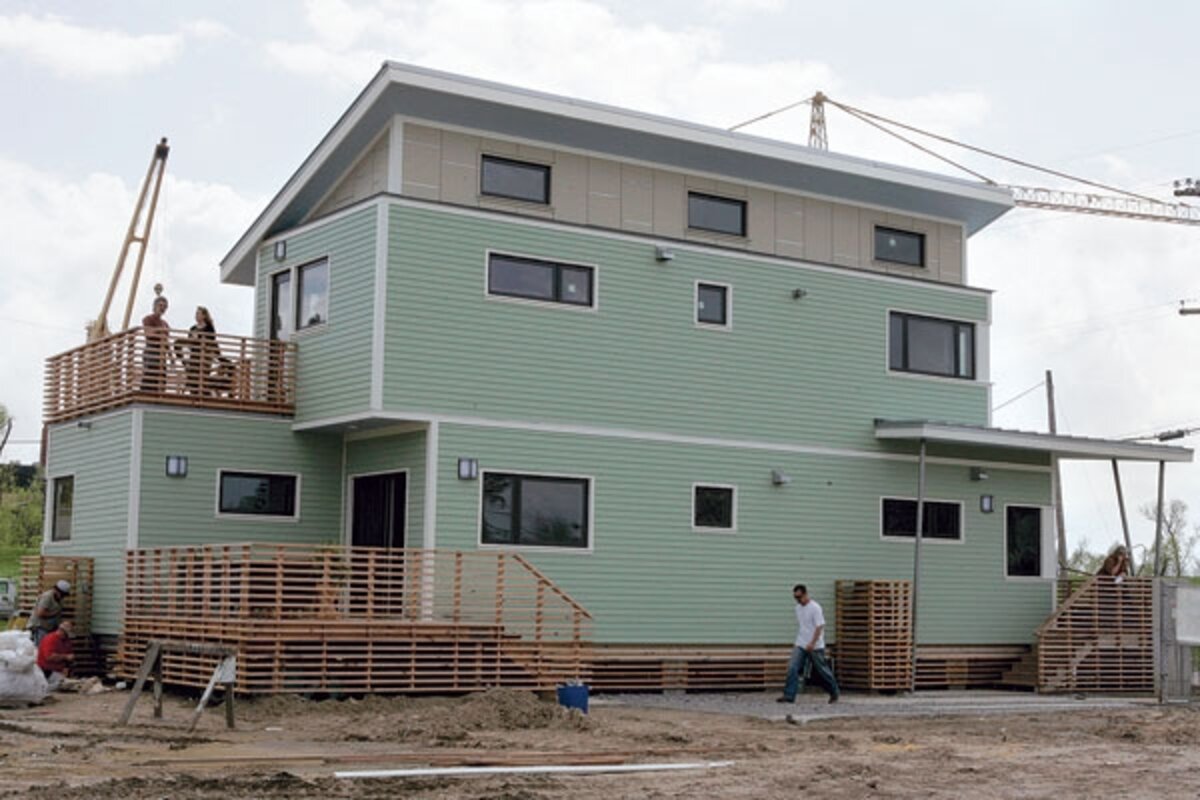New Orleans in the forefront of a green building revolution
Loading...
When hurricane Katrina blew into New Orleans four years ago, Matt Petersen watched in shock as the floodwaters retreated, revealing one of the most devastating natural disasters in US history: billions of dollars in damages, 80 percent of the city flooded with filthy water, and a government response that provoked a firestorm of criticism.
“I watched everything play out in horror,” says Mr. Petersen. “And, like everyone else, I went through the process of thinking, ‘What can I do?’ ”
Petersen donated money and considered volunteering, but that wasn’t enough. “I kept feeling this well up inside me, I felt compelled to act,” he says.
As the city’s cleanup began, Petersen, the president and CEO of Global Green, an environmental nonprofit that promotes green building, saw a silver – or green – lining in Katrina’s catastrophic wake.
“I began to think, ‘Maybe I can do more.’ I run an organization with big thinking behind it; it’s a Red Cross for the environment. We have the greatest assemblage of green building expertise. How can we deploy that?” he says. “Certainly the city was going to be rebuilt. And this great city presented us with an opportunity to create the first truly green city in our nation.”
So Petersen opened Global Green’s first New Orleans office in March 2006.
Now, four years after hurricane Katrina swept through New Orleans, he and a bevy of green-minded government employees, nonprofit organizations, volunteers, and celebrities (such as Brad Pitt) have helped transform the city into the frontier of a new green revolution.
“Now more people are interested in what we do,” says Wynecta Fisher, director of the Mayor’s Office of Environmental Affairs. “That’s what the storm did. I have had access to some of the best and brightest minds and techniques.”
As a result, the city currently operates 49 biodiesel buses and several LED stoplights, with plans to purchase LED streetlamps soon. Green, energy-efficient schools are in the works, and the city is eager to do more.
“We serve as a model,” says Charles Allen, chairman of the board of the Holy Cross Neighborhood Association in the Lower Ninth Ward. “This is how a community can recover from a major disaster. I say, look, we’re going to prove to the world that you can live in an improved, better way.”
As part of that “improved ... way,” Global Green came up with an ambitious three-pronged plan: rebuild 10,000 homes to be green, adopt a sustainable neighborhood model, and upgrade area schools to be more ecofriendly. Petersen also resolved to create local expertise in green building in order to create jobs and ensure that the effort endures.
In partnership with the city and using money from the Bush-Clinton Katrina fund, Global Green plans to improve energy efficiency and air quality of existing schools and open two new schools that will be certified Leadership in Energy and Environmental Design (LEED) silver. The schools will also help promote environmental awareness.
Global Green’s landmark initiative is the Holy Cross project, a sustainable neighborhood in the Lower Ninth Ward that will serve as a model for other communities. To generate ideas for the project, Global Green sponsored an international design competition, challenging architects to design an energy-efficient and affordable neighborhood model.
The winning proposal, designed by architects Matt Berman and Andrew Kotchen of Workshop/apd, a New York design firm, consists of five single-family homes, an 18-unit apartment building, and a community center that also serves as a sustainable design and environmental advocacy center. The goal is for all construction to use zero net energy, and be carbon neutral and LEED platinum certified.
“The idea was to design replicable, affordable, sustainable housing,” says Mr. Kotchen.
The homes, the first of which was completed in May 2008, are tall, narrow, two-story buildings wrapped in fiber cement siding and topped with photovoltaic-paneled shed roofs at 30-degree angles. Screened porches, lower roofs, and strategically placed energy-efficient windows accent the exterior.
Inside, the wood flooring has been salvaged from existing structures. Paperless drywall, or gypsum board, offers mold resistance in the humid city. Spray foam insulation prevents air leaks and increases energy efficiency. And paints use water- or soy-based solvents containing few air-polluting toxins.
It’s not just about the materials, though, says Kotchen. “It was the whole approach. For us, it’s an all-encompassing design philosophy.”
For example, he cites house and window orientation as ways to minimize sun exposure, and high ceilings and deep porches as natural cooling measures.
“Good design is green design,” he says.
Responsible waste handling is also an important part of green building. About 8,000 pounds of waste are discarded during the construction of a typical 2,000-square-foot home, according to Sustainable Sources, a green building information resource. Global Green reuses or recycles construction waste to keep materials from being carted to landfills. This also saves disposal tipping fees.
Even the homes’ landscaping is green. Porous pavement driveways allow rainwater to permeate the ground, rather than run off, carrying pollutants into nearby rivers and lakes. Rain gardens stocked with wetland vegetation border the driveways, ready to absorb and filter downpours. And shade trees planted in strategic areas – such as the sunny south side of a house – provide natural cooling.
This isn’t necessarily new, but simply good sense, says Kotchen. “Good design has been around for a long time.”
Contrary to popular thought, green design doesn’t have to be expensive. The Holy Cross homes will sell for about $175,000 and are expected to save residents an estimated $1,200 to $2,400 each year in utility bills.
“There’s an element of justice here,” says Petersen. “The question is, how do we protect the environment and provide truly affordable housing?”
This is a theme throughout the Holy Cross project, including the 18-unit apartment building. The apartments, which will be reserved for low-income residents, are expected to rent for $550 to $650 a month.
Once complete, America’s first entire LEED platinum certified neighborhood will include the first LEED platinum certified apartment building in the US.
“[The project] has created a ripple effect,” Petersen says. “It’s bringing in suppliers, creating a workforce. We’re helping create a market. It’s humbling, yet gratifying, to see what we’ve been able to accomplish to bring back this great city.”
As reconstruction continues four years after Katrina crippled the city, perhaps the most notable rebuilding isn’t happening at homes and schools, many people say. Instead, it’s happening in town meetings and neighborhood associations.
“One thing that Katrina did, it made people really look at the importance of community,” says Ms. Fisher of the Mayor's Office of Environmental Affairs. “People are engaged now. They’re not waiting for the government to do something for them. They’re getting involved.”
In some ways, then, it could be called a perfect storm. “Absolutely, there are blessings and silver linings that come out of every disaster,” says Mr. Allen of the Holy Cross Neighborhood Association.
The hurricane created an opportunity for New Orleans, he says. “We definitely have more friends, more resources at our disposal. It’s allowing us to make major strides.”
He pauses. “This is our chance.”
Editor’s note: For more articles about the environment, see the Monitor’s main environment page, which offers information on many environment topics. Also, check out our and our .




